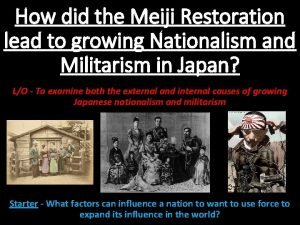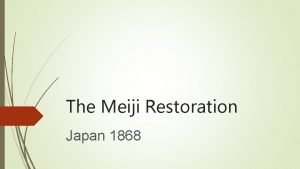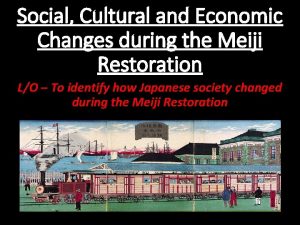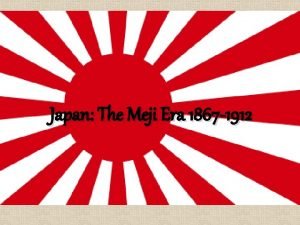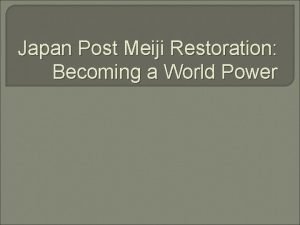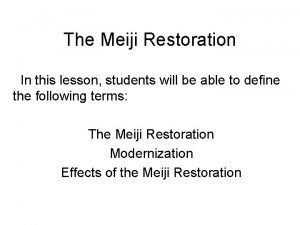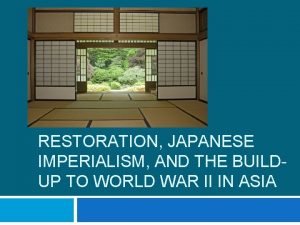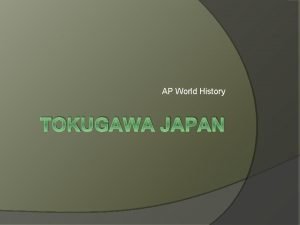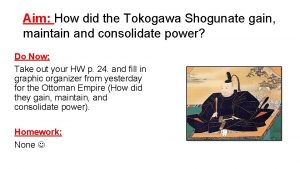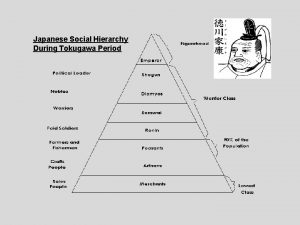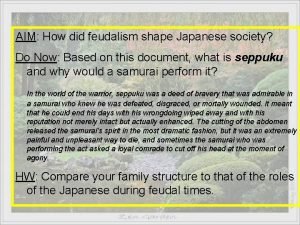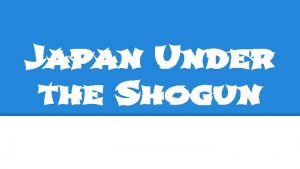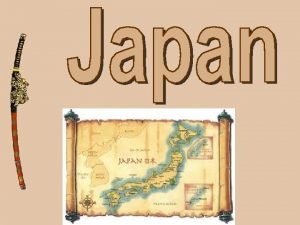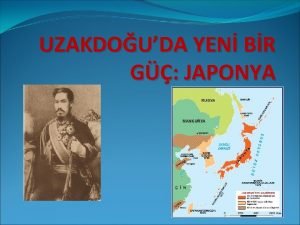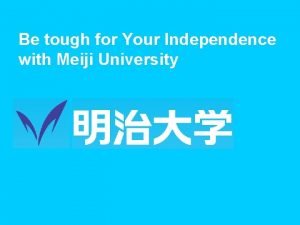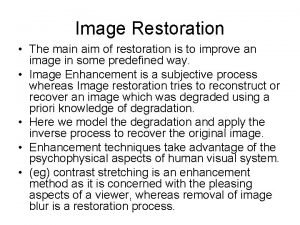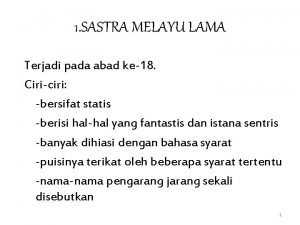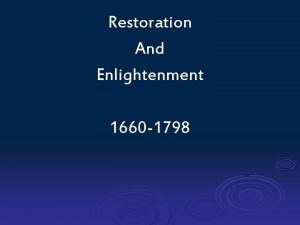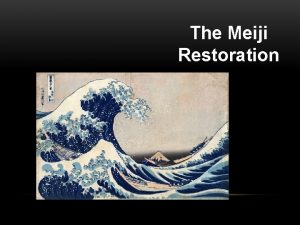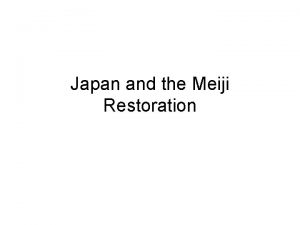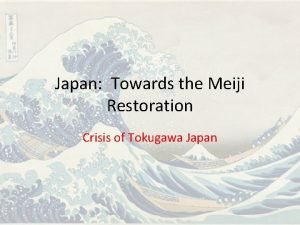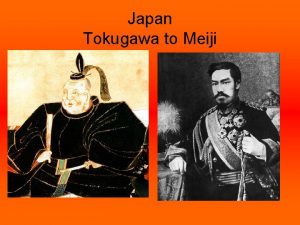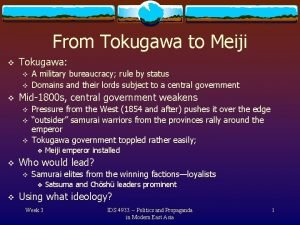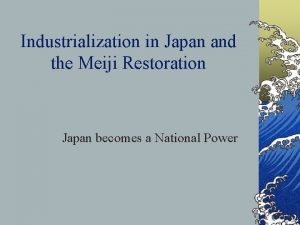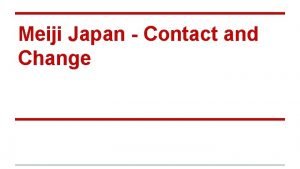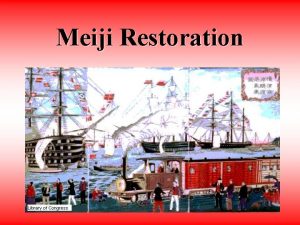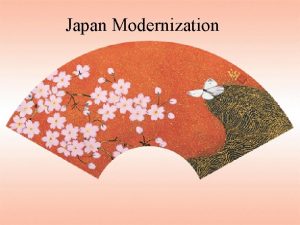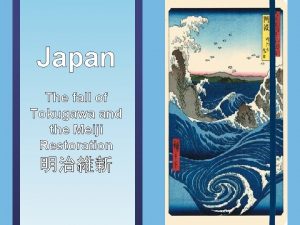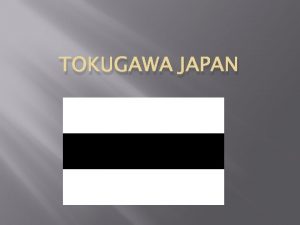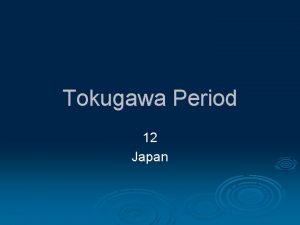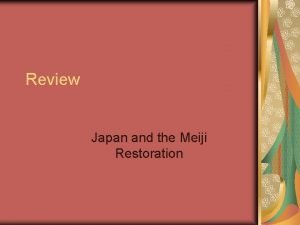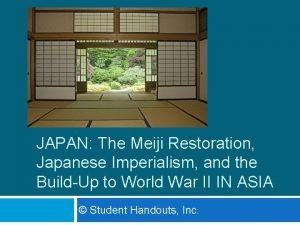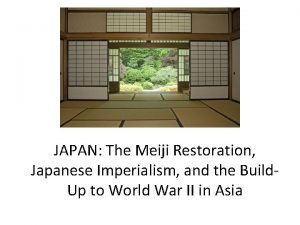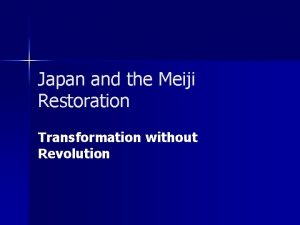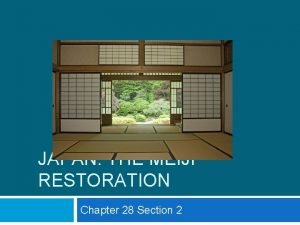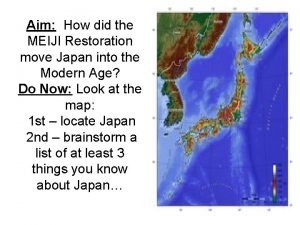Tokugawa Japan and the Meiji Restoration The Tokugawa



















![Fukuzawa Yukichi, a Meiji Reformer said: “…it is best for us [Japanese] to cast Fukuzawa Yukichi, a Meiji Reformer said: “…it is best for us [Japanese] to cast](https://slidetodoc.com/presentation_image_h2/61aca435b3059d1ea424cd4dab90865b/image-20.jpg)





- Slides: 25

Tokugawa Japan and the Meiji Restoration

The Tokugawa Background • 1600 – 1850 = Japan unified and ruled by the Tokugawa Shogunate – Shogun = military ruler – Emperor at this time basically powerless • Chief task = prevent return of civil war among the daimyo (feudal lords) – Each had own band of samurai • Shoguns brought peace to Japan for more than 2 centuries Lineage of the Tokugawa Shoguns

The Tokugawa Background • System devised to keep the daimyo in check “A Daimyo Paying a State Visit” – Daimyo required to build second homes in Edo (Tokyo) and live there every other year—their families had to stay as hostages – Daimyo still enjoyed independence in their own domains

Economic and Urban Changes • Centuries of peace allowed for economic growth, commercialization, and urban development • By 1750, most people in Japan lived in large towns or cities • Emerging capitalism, widespread literacy Japanese Teahouse during the Edo Period

Economic and Urban Changes • Merchants thrived in this commercial economy, but had low social status • Famines and social unrest led to some peasant uprisings, but nowhere near China’s scale Japanese Merchants

Europe and Japan • Since the early 1600 s, Japan had deliberately limited its contact with the West – Expulsion of European missionaries – Harsh suppression of Christianity – Japanese forbidden from leaving – Only 1 port where the Dutch were allowed to trade – Shipwrecked sailors jailed or executed • Europe and the U. S. wanted access Nagasaki Bay Dutch Port during Japanese Isolationism

What do you see? 1 4 2 3

How did Western imperialism help push Japan to become a world power?

By expanding to the Pacific in the 19 th Century, the United States had become a major world empire. Promintory Point, Utah, 1869

Polo meets Kublai Khan, Mongol Emperor of China, 1275 Many Americans began to dream of extending U. S. power across the Pacific to Asia – a dream of many empires since Marco Polo described the riches of China in the 14 th Century.

But with a 200 year head start, the “Great” imperial powers of Europe had already divided most of Asia amongst themselves…

This led the U. S. to consider opening trade with Japan – an island that had managed to keep “closed doors” to European imperialism since initial contact in the 1500 s.

As part of what would be called “open door policy” Commodore Matthew Perry, USN, was commissioned to open trade with the emperor of Japan.

In an effort to be neighborly, Perry sailed into Tokyo Bay and gave the emperor of Japan an ultimatum at gunpoint: “Eek! Okay. . . ” “Either open trade with the U. S. , or our warships will destroy your city. ” Emperor Komei

American painting (“Carrying the Gospel of God to the Heathen” (oil, 1854) ) Japanese painting (1854) How do the perspective of these two primary source accounts differ?

Perry’s Second In Command

After the U. S. “opened” Japan with warships in 1853, the Japanese knew that they had to modernize their society or be destroyed by the imperial powers of the West. In order to do this, the Emperor of Japan began a series of reforms that became known as the “Meiji Restoration”. . .

The “Meiji Restoration” became one of the most impressive revolutions in modern history… …by the turn of the 20 th Century, Japan would be one of the most powerful countries in the world. **Meiji Restoration = the revolution to modernize Japan beginning in 1868

Objective: In what ways was the Meiji Restoration a social, political, intellectual, technological and economic revolution?
![Fukuzawa Yukichi a Meiji Reformer said it is best for us Japanese to cast Fukuzawa Yukichi, a Meiji Reformer said: “…it is best for us [Japanese] to cast](https://slidetodoc.com/presentation_image_h2/61aca435b3059d1ea424cd4dab90865b/image-20.jpg)
Fukuzawa Yukichi, a Meiji Reformer said: “…it is best for us [Japanese] to cast our lot with the West. If one observes carefully what is going on in today’s world, one knows the futility of trying to prevent the onslaught of Western civilization. Why not float with them in the same ocean of civilization, sail the same waves, and enjoy the fruits and endeavors of civilization? ”

Economics Social Structure • Land tax • Samurai class stripped of power and privileges • factories built • New, modern army • state-sponsored roads and infrastructure built • education reform How did the Meiji Restoration impact: Politics • New parliament (“Diet”) created • “checks and balances” • Court system and “rule of law” -- constitution • Emperor gains back some power Daily Life • Women’s Rights • copying Western styles • people begin to work in industrial economy • Movement away from Buddhism to Shintoism


Japanese Imperialism • Japan led successful wars against: – China (1894 -1895) gained colonial control of Taiwan and Korea – Russia (1904 -1905) gained a territorial foothold in Manchuria • Japan = first Asian state to defeat a major European power


Japan’s Experience with Europe • Very different than China and the Ottoman Empire • Did not succumb to Western domination • Was able to turn itself into a powerful, modern, united, industrialized nation • Joined the “imperialism bandwagon” and created its own East Asian empire
 Japan before meiji restoration
Japan before meiji restoration Meiji restoration
Meiji restoration Meiji restoration samurai
Meiji restoration samurai Emperor shogun daimyo samurai peasants
Emperor shogun daimyo samurai peasants Meiji restoration
Meiji restoration Meiji restoration definition
Meiji restoration definition Define meiji restoration
Define meiji restoration Google japan
Google japan What hardships did daimyo face during the tokugawa period?
What hardships did daimyo face during the tokugawa period? Tokugawa social hierarchy
Tokugawa social hierarchy The tokugawa shoguns created an orderly society by
The tokugawa shoguns created an orderly society by Social hierarchy japan
Social hierarchy japan Japanese feudal system
Japanese feudal system Meiji restorasyonu kapsamında yapılan yenilikler
Meiji restorasyonu kapsamında yapılan yenilikler Latar belakang terjadinya restorasi meiji
Latar belakang terjadinya restorasi meiji Meiji university ikuta campus
Meiji university ikuta campus Koa kurenjo
Koa kurenjo Restoration drama and prose
Restoration drama and prose Enlighten about image noise and restoration
Enlighten about image noise and restoration Chapter 56 conservation biology and restoration ecology
Chapter 56 conservation biology and restoration ecology Chapter 55 ecosystems and restoration ecology
Chapter 55 ecosystems and restoration ecology Restoration drama and prose
Restoration drama and prose Image sharpening and restoration
Image sharpening and restoration The restoration and 18th century literature
The restoration and 18th century literature Restoration and enlightenment
Restoration and enlightenment Repair and restoration theory of sleep
Repair and restoration theory of sleep
